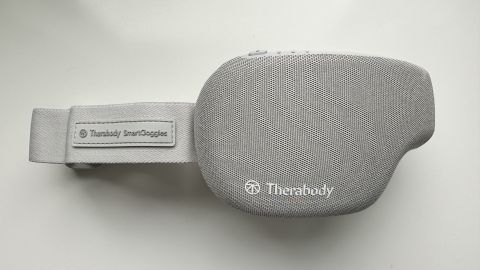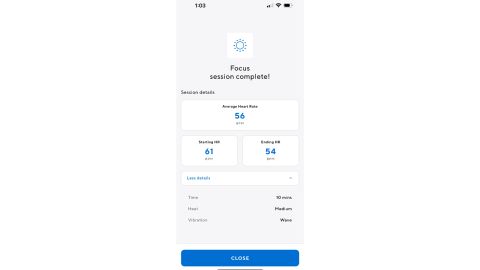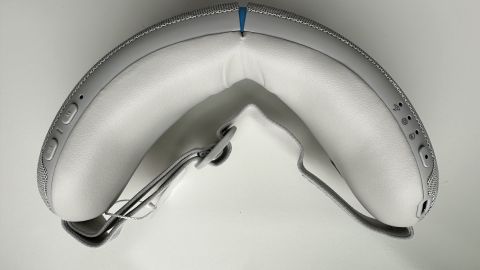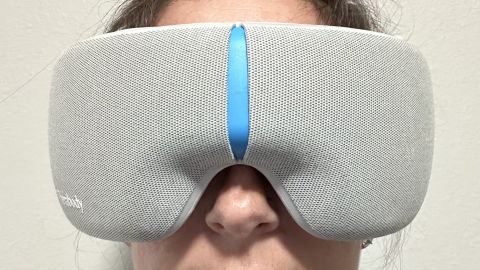If you’ve ever been laid up with a migraine, you know what a literal and metaphorical headache it can be. (I’ve suffered from intermittent migraines since high school, and have prescription meds for when they hit.) It’s estimated that 52 percent of the global population deals with active headache disorders, according to a 2022 analysis published in The Journal of Headache and Pain — and they’ll try anything from Botox to acupuncture to daith piercings to alleviate the pain.
Therabody’s new SmartGoggles offer a less invasive solution. This high-tech eye mask (from the company that popularized percussion therapy via massage guns) combines massage, heat and vibrations to ease headache pain and reduce facial tension.
Massage gun maker Therabody recently released SmartGoggles, a high-tech eye mask designed to help relieve facial tension, eye strain and headache pain using features including heat, vibration and massage. The devices also pairs with an app to provide relaxing audio content and and track relaxation results.
It’s not just those with migraines who can benefit: The average American spends over 7 hours looking at a screen every day, according to data from DataReportal. Just two continuous hours of screen time puts you at risk for eyestrain and dryness, blurred vision and headaches, according to the American Optometric Association.
Since I’m predisposed to migraines and I spend an embarrassing amount of time staring at my computer and phone all day, I was curious to see if the SmartGoggles would be enough to stave off headaches and soothe some of my screen-induced eye strain. Here’s what I found after testing them for a week.
What we liked about the Therabody SmartGoggles
They’re portable and foldable

At first glance, the SmartGoggles look like a cross between a sleep mask and a VR headset. I didn’t have a trip planned while testing these, but I would imagine they stow nicely within a suitcase or carry-on to deal with travel-induced headaches — they measure 7.9 inches by 3.5 inches when open, but fold up to 5.5 inches by 3.9 inches. Plus, they use a USB-C charging cable (the same as my GoPro and MacBook), which eliminates having to travel with yet another cord. Overall, they’re pretty comfortable, with a padded interior and an adjustable head strap. I did feel a fair amount of extra pressure around my cheekbones even when the device wasn’t in massage mode; they weigh a full pound, which is a lot to have resting on your face.
Once the goggles are powered up, there are three modes you can choose: Focus, Sleep and SmartRelax. SmartRelax is the most advanced, in that it’s powered by SmartSense, a proprietary technology that uses your biometric data (read: your heart rate) to optimize your experience. During a session, a tiny sensor on the inside of the goggles detects your heart rate and uses it to create a custom vibration pattern to help you relax more quickly.

During one five-minute session, my heart rate dropped from 61 beats per minute to 54. The other two modes use a combination of heat, vibration and massage to help you get in a more focused state of mind, or get ready for sleep. In the TheraMind section of the partner app, there are additional preset programs, like “Settle Into Sleep,” “Midday Motivation” and “Find Your Zen” that include guided meditation (I found that I relaxed more without any audio).
What we didn’t like about the Therabody SmartGoggles

Like most Therabody devices, the SmartGoggles connect via Bluetooth to the app, where you can choose your program, adjust the heat and vibration levels, and set your session time from anywhere between five and 30 minutes. But there are also controls on the goggles: just two small buttons above the left brow that control heat and vibration. I found those buttons to be completely unhelpful, because even when I was able to fumble my way to the correct button while the goggles were on my face, I’d still have to peek at the app to see what exactly I had changed. Maybe that just takes a little more practice, but the whole point of using these — to me, at least — was to escape extra screen time, so I preferred to set everything up on my phone and then leave it be for as long as the session lasted.
I did multiple sessions in all three preset modes, and I found them to feel pretty similar. During each one, the device massages the area surrounding your eye sockets, expanding and contracting to target certain pressure points (think: your temples, where your brow furrows). I didn’t feel noticeably more alert after a Focus session, or drowsier after a Sleep session; I felt equally more relaxed after each one (which is not a bad thing!). Overall, I actually would have welcomed more pressure. The device squeezed most strongly at my temples, but when I do get migraines, they almost always occur at the inner corner of my right eyebrow. On the one day I did have the start of a headache while testing, I actually had to push down at the center of the device to get even a little of the pressure I craved. The headache didn’t get worse, but it also didn’t dissipate.

I’m not sure I see the SmartGoggles as a cure for future migraines, but that doesn’t negate the benefits they do impart. I felt noticeably more relaxed after each time I used them, whether that was because of the massage, heat and vibrations or just because I had forced myself away from a screen for up to a half hour. I’m a big believer in the placebo effect, and I think just the ritual of doing this once a day could play a powerful role in stress relief — physical or otherwise — for a lot of people, and making these a regular part of a pre-bedtime routine could be a great way to wind down. For anyone who stares at a screen all day or who’s looking for supplementary headache treatments, Therabody’s SmartGoggles could be a worthy investment.




